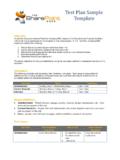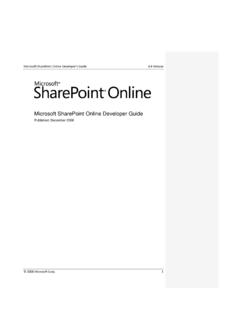Transcription of Requirements Traceability Matrix - The SharePoint …
1 Requirements Traceability Matrix The Traceability Matrix is a table that lists the business Requirements , functional Requirements , technical Requirements , and the technical features or specifications needed to fulfill the associated business Requirements . This helps the team visually determine the genealogy of a specific requirement. If a functional requirement can't be traced to a specific business requirement, then it should be removed from the project. If, in future meetings, business Requirements surface that are not on this list, then they will be voted on and either included, or marked for inclusion on future phases of this project. Business Drivers (justification) Business Requirement (Interpretation) Technical Requirement (Validation) Technical Interpretation (Specification) Intranet is SLOW. Improve server response, upload, and download times. Build new server farm with scalable topology and more robust hardware. Topology must be scalable upward (additional hardware) and outward (additional servers) Build 6 Server Farm to include: 2 WFE Servers: Dual Quad Core Processors, 8GB Ram, Dual 72 GB, 15K rpm Hard Drives.
2 2 Application Servers: Including a dedicated Index Server. Each with Dual Quad Core Processors, 16GB Ram, Dual 146 GB, 15K rpm Hard Drives. 2-Node SQL Cluster (dedicated): Each with Dual Quad Core Processors, 32GB Ram, Dual 146 GB, 15K rpm Hard Drives. This model is a 3-tiered structure that is scalable outward on all 3 levels and supports 10,000+ users WFE load balancing is not reliable Hardware Load balancers need to be updated and/or another solution needs to be implemented. Improve WFE performance and availability through a better Load balancing solution. Use Windows Load Balancing, rather than hardware load balancing. This is easier administratively and saves costs as well. Intranet content is not organized and/or relevant. Provide structure around the un-structured content across the enterprise. Create a new business taxonomy , and build an information architecture based on taxonomy and user-centric experience. Work with Taxonomy expert (consultant) to develop business taxonomy, based on user site data and survey feedback.
3 Taxonomy will include Subsidiaries, Departments, Teams/workgroups, audiences, categories, and metadata. Intranet lacks file level security, causing more sites to be created to hide data from some users within a team or site group. Provide file-level security and reduce the number of sites created for specific groups of users within departments. Enable File-Level security and audience targeting. MOSS has file-level security natively. Turn on audience targeting in the Site collection and all subsites/workspaces. Intranet Content Sprawl is out of control. Ensure that content growth is controlled and new content is posted with structure. Create a Governance Plan, detailing rules and guidelines for posting content to the Intranet. Enable Document Management strategy to control growth through quotas and content expiration. Build Governance Policy, determine content stewards, metadata Requirements , quotas, and content expiration thresholds. Review the governance policy with content stewards quarterly and update content per governance standards.
4 Employee Directory is not always updated correctly. Receptionist has to send out contacts via spreadsheet (quarterly). Provide a more up-to-date Employee directory and maintain it with regularity. Provide Employee lookup functionality, integrated with Active Directory. One source for contacts, and have it update automatically at scheduled intervals. Use SharePoint s native People Search tool. Integrate with Active Directory and schedule to update every 30 minutes. Phase II Deploy Employee Lifecycle workflow Too many paper processes still exist. Need to automate these. Automate paper processes and improve process tracking. Put workflows into place to enhance business processes, Use SharePoint workflows within team sites/workspaces. You can provide tracking, and monitor progress. monitor approvals, processes, collect signatures and more. More advanced workflows will be facilitated in Phase II using 3rd party and/or development resources. Policies and Procedures are scattered everywhere and difficult to find.
5 Create a central repository for all Policies and Procedures where they can be updated regularly and distributed to appropriate audiences Use audience targeted content web parts to collect and disseminate Policies and procedures to applicable audiences. Store Policies and Procedures at the root of the portal and use content rollup web parts to distribute content to appropriate audiences on relevant departmental sites. Use SharePoint Audience targeting on all site collections, sites and workspaces. Intranet navigation is difficult and not intuitive to new users. Improve Navigation by making it user-centric and more intuitive. Leverage input from user community, taxonomy, and information architecture to build an intuitive, global navigation structure. Create a user-centric global navigation, based on the user input, taxonomy, IA, and scenarios tested and approved by users. Documents are hard to find. Search doesn t always produce reliable results. Improve search and findability of relevant content.
6 Build content types, metadata models and a more robust search interface. Part of consultant taxonomy work define content types with appropriate levels of standardized metadata. Use Office Document Properties pane to update metadata upon publishing to intranet. Categorize content appropriately. Intranet contains too much old content Scrub content that is old, redundant, or irrelevant. Prior to moving data to the new environment, make sure metadata is current and complete, set standards for legacy content prior to moving it into the Use Governance Policy, Metadata, Document Management functionality in MOSS, and Content stewards to review content prior to importing to new environment. MOSS, then quarterly thereafter. Every site looks different; it s hard to locate appropriate content. Improve usability through standardized content templates and sited branding. Create consistent and predictable site-level templates, enabling users to find content in the same place, regardless of what department or team site they visit.
7 SharePoint site templates and master pages provide a consistent layout as defined by the business users. Specified content will consistently be located in the same place on each departmental/team site. Sites can use targeted content, item level security and reusable content web parts with content filters included. Create templates for Portals, Site collections, Sites, and Team workspaces. We will brand them to have a more pleasing and functional appearance. Workflows are difficult to create and IT is a bottleneck in this area. Enhance business processes via the use of workflows that users can create themselves. Enable workflows in Collaborative spaces, giving teams the ability to create ad hoc workflows, removing the IT bottleneck. MOSS has wizard-driven workflows built-in. More robust workflows will use 3rd party or Development resources. Need better integration with Company Subsidiaries Provide a more reliable model for integration of regional subsidiary sites.
8 Create regional deployment model to be discussed with other subsidiaries. Build Intranet environment such that current and future integration with subsidiaries is possible.



